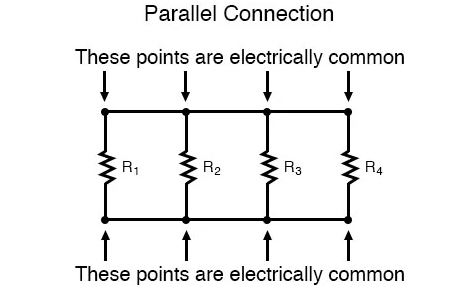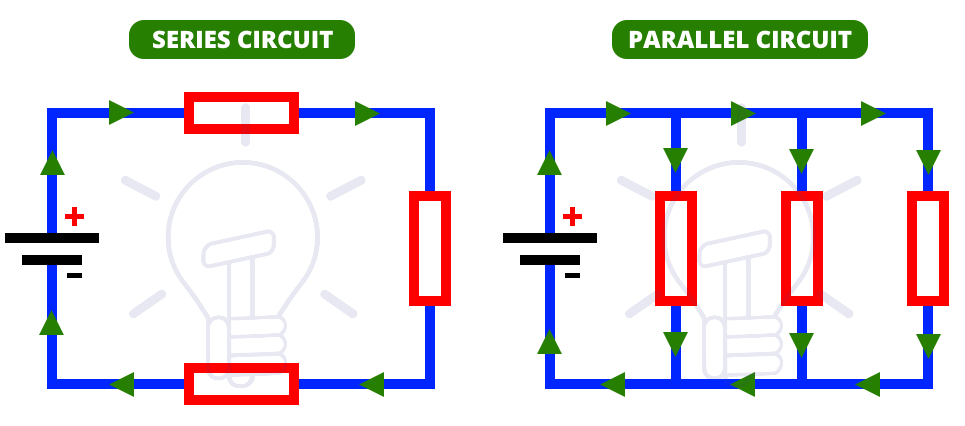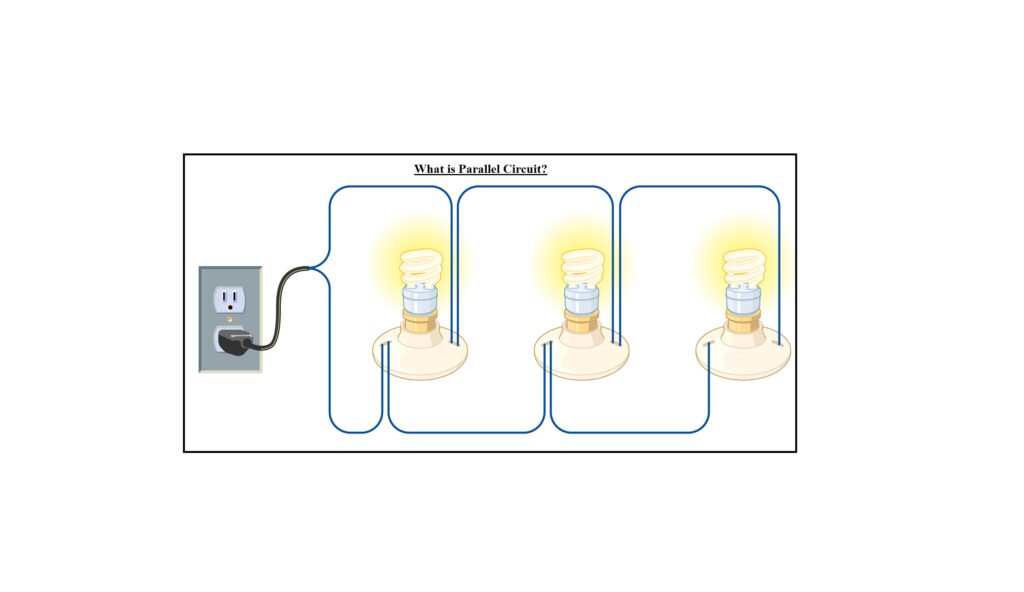What is the definition of a parallel circuit? Circuit elements in electrical circuits can be configured in series or parallel. The elements in parallel circuits each has their own branch. The current in these circuits can take a variety of pathways. The current in a parallel circuit does not always follow the same path since it can take different paths. Instead, the voltage or potential drop across each branch is constant for branches that are connected in parallel. Because the current is inversely proportional to the resistance of each branch, it divides itself throughout each branch into inversely proportionate amounts. As a result, when the resistance is lowest, the current is largest, and vice versa.
How We Write this Blog Post about What is Parallel Circuit
The process of writing this blog post about what a parallel circuit is, entails conducting extensive research, consulting with experts, and drawing upon prior experience and knowledge. To begin, we researched various sources such as books, online tutorials and other websites, to gain a comprehensive understanding of the concept of a parallel circuit.
We consulted with electrical engineering experts to get their perspectives on this topic, and to ensure that the information we were gathering is accurate and up-to-date. We also took the time to visualize the concept through diagrams and animated simulations, to make the learning experience more engaging and memorable.
We understand that a parallel circuit is a fundamental concept in electrical engineering, and it is crucial to convey this information in a clear and concise way, so that readers can quickly grasp the concept and apply it to real-life situations. At the end of the research and writing process, we believe that this blog post will serve as a valuable resource for anyone who needs to understand what a parallel circuit is.
What is a Parallel Circuit?
A parallel circuit has branches that divide the current so that just a part of it passes through each branch. On the other hand, the essential concept of a “parallel” connection is that all components are linked across each other’s leads. No matter how many components are connected in a purely parallel circuit, there are never more than two sets of electrically common points. There are numerous current flow pathways, but only one voltage exists across all components:

Parallel circuits allow charge to pass across two or more routes due to these characteristics, making them a popular choice for use in houses and electrical equipment with a reliable and efficient power supply. When a component of a circuit is damaged or destroyed, electricity can flow via other parts of the circuit, and power can be distributed evenly over multiple buildings. A diagram and an example of a parallel circuit can be used to explain these features. Visit here to explore more about parallel circuits.
Parallel Circuit Configuration
Let’s have a look at the special form of circuit, the parallel one:

We have three resistors this time, but they form more than one continuous current route this time. One path leads from 1 to 2 to 7 to 8 and back to 1. Another goes from 1 to 2 to 3 to 6 to 7 to 8 and then back to 1. There’s also a third path that goes from 1 to 2 to 3 to 4 to 5 to 6 to 7 to 8 and back to 1. Each path (via R1, R2, and R3) is referred to as a branch.
A parallel circuit is distinguished by the fact that all components are linked to the same set of electrically common terminals. We can see that points 1, 2, 3, and 4 are all electrically connected in the schematic diagram. Points 8, 7, 6, and 5 are also in this category. Between these two sets of points, all resistors, as well as the batteries, are connected.
The complexity does not, however, end with simple series and parallel! We can also create circuits that are a mix of series and parallel.
Parallel Circuit Characteristics
Parallel circuits use branches to allow current to flow in multiple directions via the circuit. Current flows from the positive to the negative end of a battery or voltage source. The current changes depending on the resistance of each branch, while the voltage remains constant throughout the circuit.
Parallel circuits are set up in such a way that current can flow through different branches at the same time. Voltage, not current, remains constant throughout, and voltage and current may be calculated using Ohm’s Law. The circuit can be handled as both a series and a parallel circuit in series-parallel circuits.
Parallel Circuits Calculations
A parallel electronic circuit is one that has two or more electronic components connected in such a way that each component’s lead is connected to the corresponding lead of every other component in the circuit. It is simple to connect a parallel circuit with two resistors. Connect the first resistor’s left lead to the second resistor’s left lead first, then the right lead of the first resistor to the right lead of the second resistor.
Product-Over Sum Rule
Using the product over the sum rule is one of the simplest techniques to compute the equivalent resistance of two parallel resistors. The equivalent resistance is equal to the product of the two resistors divided by the sum of the two resistances, according to this rule. If a 2-Ohm resistor were connected in parallel with a 6-Ohm resistor, the product would be 12 and the sum would be 8. Because 12 divided by 8 equals 1.5, the product over the sum would be 1.5.
Power Supply Current Problem
Two resistors are frequently linked in parallel before being connected across the terminals of a power supply. A common challenge with such a system is determining the entire amount of current flowing from the supply. The current flowing from the battery is equal to the battery voltage divided by the equivalent resistance of the two parallel resistors, according to Ohm’s law. The current from the battery would be equal to 10 amperes if the battery voltage was 15 volts and the equivalent resistance was 1.5 Ohms because 15 divided by 1.5 equals 10.
Branch Currents
Branch currents are the currents that pass through each parallelly connected resistor. Like water in a river, current from a battery splits between the resistor branches as it reaches the point (node) that joins the branches of a parallel resistor circuit. The overall current from the power source will be equal to the sum of the current in the two branches. The quantity of current in each branch, however, will be determined by the value of the branch’s resistance. A branch with a lower resistor value will have greater current than a branch with a higher resistor value.
Branch Current Calculations
When a 15 Volt battery is connected in parallel with a 6-ohm and 2-ohm resistor, the current flowing through the 6-ohm resistor is equal to the voltage across the 6-ohm resistor—that is, 15 Volts divided by the resistor’s value of 6 ohms. Because 15 divided by 6 is 2.5, the current would be 2.5 amperes. Similarly, because 15 divided by 2 is 7.5, the current through the 2-ohm resistor would be 7.5 amperes. As illustrated above, the total branch current, 7.5 plus 2.5 or 10 amperes, must be equal to the battery voltage divided by the equivalent resistance.
Voltage Drops Across Parallel Components
It was mentioned earlier in the discussion of how to measure the voltage that voltage drops across parallel components in a circuit are the same. Kirchhoff’s voltage law states that in a closed-loop, the sum of all voltages (the positive voltage from the power source and the voltage drops from components) must equal zero.
You can create a loop using any of the parallel branches and the batteries in a parallel circuit with several branches. The voltage drop across any branch must therefore be equal to the voltage delivered by the battery, regardless of the component on each branch (ignoring the possibility of other components in series, for simplicity). This is true for all branches; therefore, voltage drops between parallel components will always be equal.
Equivalent Capacitance of Parallel Capacitors
The analogous result for parallel capacitors comes from Q = VC, the fact that the voltage drop between all parallel capacitors (or any elements in a parallel circuit) is the same, and the fact that the charge on the single equivalent component will be the total charge of all the individual capacitors in the parallel arrangement. As a result, the total capacitance, or equivalent capacitance, may be represented in a simpler manner:
{C}_{eq}={C}_{1}+{C}_{2}+{C}_{3}+…{C}_{n}
Differences & Similarities Between a Parallel Circuit & a Series Circuit
Series and parallel circuits are the two most common types of electrical circuits. Components in a series circuit are connected in a “daisy-chain” topology, with the first and final devices connected to the power supply. The electric current flows in a closed loop from the source to each device, then back to the source. Every device receives the same amount of current, and each has a voltage drop equal to its resistance times the current.
A parallel circuit, on the other hand, connects the devices like the rungs of a ladder. Current runs into one “leg” of the ladder and out the other, branching into each rung along the way. The voltage across each device is the same, but the currents flowing through them may vary based on the resistance of each one.

When electrons, negatively charged particles, move from one atom to another, electricity is formed. Because there is only one path for electrons to move in a series circuit, a break anywhere along that channel blocks the flow of electricity throughout the circuit. A parallel circuit has two or more branches, each of them creates a separate channel for electrons to flow, so a break in one branch does not affect the flow of electricity in the others.
Current
The current in a series circuit is specified by the most significant and fundamental law of electricity, known as Ohm’s Law. Ohm’s Law states that I = V/R, where I is the electrical current, V is the voltage given by the source, and R is the overall resistance of the circuit, which is the resistance to the passage of electric current. The current in each branch of a parallel circuit is inversely proportional to its resistance, and the total current is equal to the sum of the currents in each branch.
Voltage
The potential difference, or voltage, in a series circuit, decreases as the force that “pushes” the electrons around reduces across each component in the circuit. The voltage drop across each component is proportional to its resistance, so the total voltage supplied by the source is equal to the sum of the voltage drops. Each component in a parallel circuit functionally links the same two points of the circuit, resulting in the same voltage for all components.
Resistance
The total resistance of a series circuit is just the sum of the resistances of the circuit’s components. Because current can travel through multiple pathways in a parallel circuit, the total overall resistance is lower than the resistance of any one component.
Similarities
Aside from the fact that both are used to link electrical components such as diodes, resistors, switches, and so on, serial and parallel circuits have few similarities. In series circuits, the current flowing through each component is the same, whereas, in parallel circuits, the voltage flowing through each component is the same.
Parallel Circuit Specifications
Same Voltage Across all Branches
The voltage across a parallel circuit remains constant regardless of whether there are multiple power sources or only one. This is due to the fact that the voltage from the power sources is distributed across the entire circuit. If your circuit requires many voltages at different locations, you’ll need to manage the voltage with resistors or voltage regulators.
Complex Current Paths
The current from the power source is split throughout the circuit in a parallel circuit. As a result, depending on the resistances of each branch, different amounts of current flow. Furthermore, when you add branches to the circuit, the overall current grows; you must ensure that your power source can handle the additional current, otherwise, the entire circuit would be starved of power. This means parallel circuits can’t be employed where a consistent current is required.
Complex Circuit Loading
When branches are added to a parallel circuit, the voltage remains constant throughout, requiring a change in current flow to compensate. When more resistors are installed in additional branches, this has a knock-on effect on the circuit’s overall resistance, resulting in a lower resistance in the circuit. Adding resistors in series with each other and on existing branches is the only technique to increase resistance.
Disadvantages to a Parallel Circuit
The current in a parallel electrical circuit breaks into several branching channels. Numerous current routes are generated by either numerous power sources flowing to a single output or a single power source running to multiple outputs. The parallel circuit’s branching structure can lead to complex design challenges and other disadvantages.
Parallel Circuit Problems
Parallel circuit problems come in a variety of forms. Calculating the total resistance of two resistors in parallel, also known as the equivalent resistance, is a typical problem. Calculating the current in a parallel resistor network when it is coupled to a power supply is another issue.
The Use of a Parallel Circuit Connection
Battery Current
When batteries are connected in parallel, the total possible battery current increases. In terms of ampere-hours, the total quantity of electrical current from parallel batteries is equal to the sum of the ampere-hour ratings of each battery in parallel. Only use batteries with the same voltage when connecting them in parallel. Also, keep in mind that the voltage across parallel batteries will be the same as the battery voltage. They won’t add up like they would in a series connection.
Light Emitting Diodes
Electronic components that emit light when a voltage is applied, such as light-emitting diodes (LEDs), are frequently stacked in parallel and series. When LEDs are arranged in a parallel configuration, one LED light will die off while the others remain lit. When one of the lights in a series LED setup goes out, all of the others go out with it. In comparison to parallel LED setups, series LED configurations require less electrical current to operate.
Different Resistor Values
When a resistor is connected in series with other resistors, the series resistors’ total resistance equals the sum of the resistor values. This property of resistors in series allows you to make higher-value resistors by simply joining them in series.
When a resistor is connected in parallel with other resistors, the total resistance of the parallel resistors is less than the lowest value of each of the parallel branches. For calculating the overall resistance value of parallel resistors, designers employ a particular formula.
Buy Equipment or Ask for a Service
By using Linquip RFQ Service, you can expect to receive quotations from various suppliers across multiple industries and regions.
Click Here to Request a Quotation From Suppliers and Service Providers
Read More In Linquip
- Types of Electric Circuits: All Classification with Application
- How does a Circuit Breaker Work?
- What is Resistive Circuit
- What is Linear Circuit
- What is RL Circuit
- What is RC Circuit?
- What is RLC Circuit
- What is Capacitive Circuit?
- Types of Resistor: Classification, Application, and Finally Clarification
- What is Closed Circuit? Definition & Example
- What is Short Circuit? A Clear Definition & Protection Guide
- What is Open Circuit? Diagram & Example
- Difference Between Linear and Nonlinear Circuits
- What are the Differences Between Series and Parallel Circuits?
- A Complete Guide to Impedance and Reactance




Thanks
Perfect refresher of the basics! Thanks, I needed that.